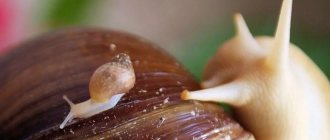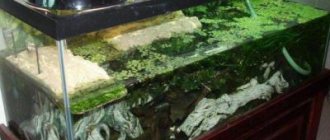Red-eared turtles are very popular among reptile owners.
Reproduction of these animals at home requires knowledge of the basic rules and recommendations for their breeding. It is known that the sexual activity of turtles kept in captivity is at a low level, which is why offspring are extremely rare. The poor birth rate of this species of reptile is also explained by the incompetence of the owners regarding how red-eared turtles reproduce and the inability to create suitable conditions for this.
How does reproduction occur in land reptiles in the wild?
In the wild, turtles begin to breed in the spring - this is a favorable time, since the laid eggs can warm up all summer. It is quite easy to distinguish a male from a female: the former have a small depression on the plastron.
In the wild, in order to attract the attention of a female, males make funny loud sounds, more reminiscent of the yelping of dogs. And in order to win the female’s favor, they fight with each other. The winner receives the main prize - the opportunity to mate. Sexual intercourse of land turtles lasts no more than 10 minutes.
A pregnant turtle carries its offspring for three months. During this time, the female manages to find the right place for laying, which is well warmed up by the sun's rays. In the selected area, the turtle prepares small depressions for eggs (no more than 10 cm deep).
The number of eggs in one clutch may vary, depending on the age of the reptile and its species. It is noteworthy that the older the turtle, the more offspring it has. A pregnant land turtle makes one to three clutches of 70 eggs each. Then she irrigates all the clutches with liquid secreted from the urinary and anal passages. Thus, she eliminates the smell of eggs and protects her cubs from pests.
Newborn turtles, depending on the species, are born after about two months. Some offspring survive the winter underground, in tunnels prepared in advance by turtles, located next to the clutch.
Hatched young turtles immediately begin to crawl towards the water - this is their basic instinct. Relying only on their own strength, not all of them will reach the sea waves. Some will get lost halfway, while others will simply be eaten by seagulls and small predators.
External signs of male and female turtles
To determine the sex of a turtle, the animal must be sexually mature. In nature, turtles reach sexual maturity at the age of 6-8 years, at home - at the age of 2-5 years. At the same time, it should be borne in mind that the larger the animal, the longer puberty occurs.
If the age of the animal corresponds to the declared one, then we have the opportunity to find out the gender based on the following anatomical characteristics:
- claw length;
- paws;
- carapace, plastron;
- size;
- tail and cloaca.
So, let's look at these signs in more detail.
Claws
As a rule, the front claws of males are stronger and longer than those of females. Visually, this is quite easy to determine, because the difference in the length of the claws of males and females is quite significant. Long claws help the male hold the female during mating.
Paws
Another option for determining the sex of a turtle. To do this, you need to carefully examine the inside of its paws. If you find small scales, then you have a boy. In addition, males have femoral spurs.
Carapace, plastron
Each type of turtle has its own shell, different from other species. The carapace is divided into two parts: the dorsal (carapace) and the ventral (plastron).
The carapace and plastron in males and females have the following differences:
- the shell may vary in color. For example, a blue plastron on a painted turtle indicates a boy. If the plastron is a different color, it's a girl;
- The shape of the male turtle's shell is more elongated, while that of the female is rounded;
- in males the plastron is concave for ease of mating, while in females it is flat;
- The end of the plastron of males has a clear V-shape, while in females it is rounded and has an opening.
Size
In most species of turtles, boys are larger than girls because the females need to carry the eggs. The exceptions are Galapagos turtles (Geochelone nigra), South African turtles (Chersina angulata), desert turtles, box turtles (Terrapene carolina), Mullenberg's turtles (Clemmys muhlenbergii), American marsh turtles (Emydoidea blandingii), snapping turtles and yellow mud turtles (Kinosternon flavescens).
Tail and cloaca
Males have a longer and thicker tail. The tail of females is thinner and thicker, which is due to the presence of an oviduct in their cloaca.
Sometimes you can see the turtle's penis emerging. If you touch it with your hand, the penis will hide.
The male's cloaca is located towards the end of the tail and is shaped like a line. In the female, the cloaca is located at the base of the tail and has a larger opening than in the male.
The breeding process of domestic land turtles
To start raising reptiles at home, you will need certain conditions. The turtle owner needs to organize:
a strict weekly diet before wintering;
wintering (2 months), after which male and female individuals will become more active and energetic;
removal of gentlemen from females;
after waking up, increase the temperature in the terrarium, thereby forcing the sex hormones of the reptiles to work.
At 7-9 years old, females are ready for the first reproduction, males mature earlier and are ready to mate by the age of six. Males should be placed with females after 7 days from awakening. Males in the new territory will not be so aggressive and will be able to reproduce normally. The owner must closely monitor the cavaliers so that they do not cause serious injuries to each other during battle.
During mating, different types of turtles behave differently, some gently touch their shells, sending vibrations to the female, and more active males prefer to painfully bite the female on the paws and attack her shell.
The partner’s disposition will be immediately noticeable, and she will easily allow the candidate to approach her and will not be against the start of mating. During sexual intercourse, the male climbs onto the female, holding her with his paws. As soon as copulation ends, both partners let out a cry, which means the end of the act. Successful fertilization occurs after 2-3 sexual intercourse, so owners of reptiles should not rush to transfer the male to another terrarium.
While the pregnant turtle is bearing its offspring, the owner needs to take care of the following details:
prepare a container with sand in which the female will lay eggs;
Set up an incubator to keep small reptiles, about 2-3 months after birth. The temperature should not exceed 30 degrees, and the humidity should not be lower than 80%;
review the pregnant woman’s diet, double the amount of food, add vitamin and mineral supplements.
The approach of childbirth can be judged by the behavior of the female. She becomes more restless, refuses to eat and begins to dig holes in the sand.
As soon as the eggs are laid, it is better to move them to an incubator, where the necessary humidity and temperature conditions will be maintained.
Conditions for mating
Reproduction of the red-eared turtle is possible subject to the optimal age for mating - individuals must be young, but at the same time have reached sexual maturity. The readiness of females to reproduce is observed at the age of five, males begin to give birth to offspring in the fifth year of life. If you keep more than two turtles at the same time, it is advisable that there is only one male among them, otherwise the males will fight for the opportunity to mate, causing injury to each other.
Pond slider
Breeding problems
Any turtle breeder faces breeding problems. The most common mistakes are:
unfertilized eggs. In the absence of males, turtles lay “empty” eggs. Only after copulation does conception and successful laying occur;
failure to maintain humidity and correct air temperature in the terrarium;
the absence of mating games negatively affects the interest of males in young females. The partner must win the female, become the winner and receive the desired prize;
a poor diet and lack of vitamins also negatively affect the offspring.
Selection of breeding material
When breeding exotic animals, take care of the health of the offspring. It is important to select healthy, mature female and male turtles of the same species and subspecies. Use turtles from different breeding lines; possible inbreeding increases the risk of producing genetically deformed offspring.
If mating occurs between different species/subspecies, the eggs may be infertile, or the subsequent offspring may be so. This practice is discouraged as it leads to the destruction of the species.
How are sea turtles bred in captivity?
Marine reptiles reproduce in nature much more easily than in captivity. Males actively court females and fight with competitors. Representatives of red-eared sea turtles have gentle and careful flirtations with the female. The male swims up to his lady and, stretching out his front legs, begins to vibrate them. The female, feeling the vibration of the male with her cheeks, either allows him to continue courtship, or stops all advances.
Male freshwater turtles engage in bloody fights in the fight for a female. Males also make loud noises during the mating season. But in the end, the one the partner chooses wins. If the losing gentleman does not lag behind, then the angry female can bite him severely.
Another feature of sea turtle breeding is the environment. Male reptiles are ready to swim thousands of kilometers to mate with females. After all, only on the territory of the ladies do mating games begin.
Sexual intercourse takes place in water and lasts from 5 to 15 minutes. The chosen one swims up to the female from behind, holding her with his forelimbs. Pregnant marine reptiles carry their offspring for two or three months, and begin laying where they themselves hatched.
Having chosen a place for laying, the pregnant individual digs a deep hole with its hind paws, at the same time wetting the sand with secretions from the urinary and anal tracts. One individual lays up to 100 eggs at a time. The total number of clutches per season is 3-4 pieces. Sea turtles are the only ones that lay their eggs only at night. After completing the laying, the turtle buries the hole with sand and levels it with its belly.
Of the numerous offspring, only a few survive in the wild. It's all about predators who happily feast on fresh eggs.
Peculiarities of behavior of males and females
If you observe the behavior of turtles, you will notice that females are more passive than males. Females barely move and prefer a sedentary lifestyle. Males are more active, even more aggressive. Only males exhibit sexual energy. Turtles - girls can manifest themselves in this way only in childhood, imitating the behavior of males.
Sex determination in different turtle species
Turtles are divided according to their habitat into the following species:
- aquatic;
- land;
- forest
Water
One of the representatives of aquatic turtles is the red-eared slider.
You can distinguish a boy from a girl red-eared turtle by the following characteristics:
- the plastron is curved in a boy and straight in a girl;
- long curved claws for a boy and short rounded ones for a girl;
- a longer and wider tail is a sign of a boy;
- If you compare a boy and a girl, the girl will be larger.
So, determining the sex of a red-eared slider is not as difficult as it seems at first glance.
Land
One of the representatives of land animals is the Central Asian turtles.
Let's look at how to distinguish between female and male land turtles:
- The claws, like those of aquatic turtles, are longer and thicker in male land turtles. But this cannot be a reliable indicator, because the claws of land turtles can be worn down;
- the concavity of the plastron in boys distinguishes them from girls, whose plastron is flat;
- in girls the tail is completely visible, in boys the shell in the back bends towards the ground and covers the tail;
- girls have tubercles on their shell, boys have them only in childhood and smooth out as they grow older;
- Girls' shells are wider than boys' and have a rounded shape. In males it is narrower and longer;
- The male's tail contains the genital organ, as a result of which the tail is longer and wider than the thin and short tail of the female.
Forest
Male wood turtles are distinguished by a long, thick tail and a concave plastron, which is narrower and longer than that of females.
Interesting Facts
Sea turtles appeared about 200 million years ago and have remained virtually unchanged.
Scientists have concluded that all species of sea turtles are descended from one single species; These animals, while underwater during sleep, are able to hold their breath for almost two hours;
All sea turtles are excellent divers, for example, leatherback turtles, in pursuit of their favorite delicacy - jellyfish, are able to dive hundreds of meters. It would seem that when diving to such a depth, very high pressure could rupture the air-filled lungs, but this does not happen. Thanks to their unique structure, these sea turtles push air out of their collapsing lungs.
After this, they begin to consume the oxygen stored in the red blood cells and muscles. Unlike most mammals, turtles have a higher concentration of red blood cells, as well as a lot of myohemoglobin, an oxygen-binding protein found in muscles.
Constantly swallowing seawater would kill a sea turtle if nature had not endowed it with special salt glands that go into the eyes, along with the tear ducts. With the help of these glands, the turtle gets rid of excess salt in its body. When the female comes to the beach to lay her eggs, she appears as if she is crying. But these are not tears, but a secretion that is secreted by these glands, protecting the turtle's eyes from the sand that gets into the eyes when it digs a hole to lay its eggs.
Preparation
Getting red-eared turtles to breed in captivity is quite a difficult task. To achieve the desired result, you first need to take care of your pets’ diet. Reptile food should include vitamins and nutrients. Vitamin E is especially useful for males, as it has a positive effect on the reproductive function of animals. Calcium and phosphorus are useful for the normal course of pregnancy in females.
Before the intended mating, two turtles need to be placed in different aquariums. To create a suitable environment, it is recommended to change the water and heat it to 25 o C. It happens that during the mating process, the male does not allow the female to come to the surface for a long time. To prevent the reptile from suffocating, the water level in the aquarium should not exceed 10 centimeters. A container with sand must be placed inside the vessel, where the female will lay eggs.
It should be located in a dry area that is easily accessible to the turtle. Please note that mating will only occur if there is soil in the aquarium. A sign indicating that the female is ready to reproduce is the reptile displaying high activity, as well as its refusal to eat.
What to do if the turtle managed to escape?
- First you need to put a bowl of water, and next to it a bowl of your favorite food. It is impossible that fresh and clean water could not interest this amphibian, and even more so, its favorite food. They have excellent eyesight and are able to spot treats from a great distance.
- If there is no reaction, and about 2 hours have passed since the escape, then you should fill several containers with water and place them in different places, such as dark corners, the space under the sofa, bed, under the table; this is necessary so that the turtle can find the nearest water and at least a little, but stay in it.
- Several hours without water can negatively affect its health: both its shell and skin can suffer. Under such conditions, the shell may begin to delaminate, and the delicate skin will begin to crack, as a result of which microcracks may appear on the skin, which will take a long time to heal.
- If time is running out and the turtle does not appear, then it is advisable to intensify the search, looking at all potentially dangerous places, since the pet could simply fall into a “trap”, despite the fact that they are able to actively move and overcome obstacles.
- The turtle can simply hide in a secluded place. As a result of active searches, contact with the turtle can be established. If she sees that someone is approaching her, she will certainly react to this by giving a kind of signal in the form of a whistle or clicks.
- If an adult turtle falls unsuccessfully onto its shell, it will be very difficult for it to get up, especially if there are some obstacles nearby.
Additional heating
In the wild, the red-eared turtle loves to bask in the sun . Instead, a simple incandescent lamp and an ultraviolet lamp should be hung above the “island”. The latter is needed to ensure the normal development and growth of the red-eared turtle, as well as to prevent various diseases. The ultraviolet lamp should be located 50 cm above the “island”. It should first be turned on for 5 minutes 1-2 times a week, gradually increasing the duration to 30 minutes and the frequency to every day. It is advisable to install a thermometer to control the air temperature (it should not be more than 30 degrees).
Incubation of turtle eggs
Turtle incubator diagram
While in captivity, turtles are able to lay eggs at any time of the year. For mating to occur, several males are needed to compete for the female's attention. One male will not show interest in a female. After mating, females need vitamins E and D, as well as large amounts of calcium. The female can also lay unfertilized eggs. But if you know for sure that you have both males and females, and they had the mating process, then you can try to incubate such eggs.
Turtles can also lay eggs on the floor, but it is better to build a special box for this purpose. It is important that the female is able to dig a hole in it. The substrate that is characteristic of the wild habitat of this turtle is placed in the box. This is sand or a mixture of sand, peat and sphagnum, which must be moist. The laid eggs must be quickly transferred to the incubator. It is important not to turn the eggs for the first 5-6 hours after laying, because the embryos will die. Therefore, when you take the eggs out of the substrate, draw a cross on their top or write the egg number.
To incubate eggs, you can take microwave containers, cover the cells with a layer of damp substrate (about 5 cm) and make small holes in it, then carefully place the eggs in them (without burying them). After a couple of days, you need to check whether all the eggs have survived, and remove the dead ones from the container. If fungus appears on the eggs, it must be removed using an antiseptic solution for mouth rinsing, diluting it with water, using a one-to-one ratio.
A good incubator option is a 20 liter aquarium. A heating element with a thermostat is placed in it, and several bricks are also placed. Next, the aquarium is filled with water to one third or one second of the volume. A cuvette with eggs is placed on the bricks, which should not touch the water. The temperature in the aquarium should be 25-30 °C. The incubator should be kept away from sunlight and drafts.
Before being born, a small turtle makes a hole in its shell. For about a day, while still in the egg, she feeds on the contents of the yolk sac. You cannot remove a turtle from an egg yourself! They are transferred to small aquariums, at the bottom of which a mixture of wet sand and peat is poured. Forest species of turtles do not tolerate dry air. They need the same temperature in the aquarium as adults.
Small turtles need to be fed plant foods with the addition of calcium supplements. To obtain vitamin D, they are irradiated with ultraviolet lamps.
What are these turtles?
Each of us has seen a turtle at least once in our lives. Not necessarily live - for example, on TV or in a picture in a magazine. These are unusual animals belonging to the order of reptiles. Their distinguishing feature is the presence of a shell. As a rule, turtles combine water procedures with movement on land - this is not surprising, given that they are a reptile species.
Turtles are known to live a very long time. Under natural conditions, they can live to a “very old age” - approximately 90-100 years. It is believed that certain species are capable of living much longer - up to 300-350 years, but there is currently no proven evidence of such longevity. The record is 188 years.
Turtles are quite unusual animals
Turtles are one of the most ancient reptiles on our planet. If you look at them carefully, they look more like some kind of prehistoric creatures. Evolution has not changed them much over the years, since turtles initially have a harmonious body, and are able to adapt to almost any environmental conditions.










